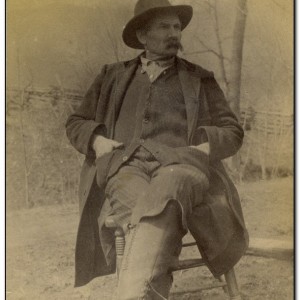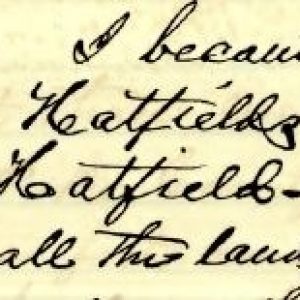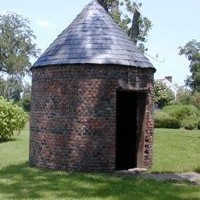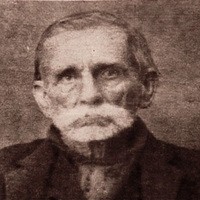“To one who has faith, no explanation is necessary. To one without faith, no explanation is possible.”
This quote is almost universally attributed to St. Thomas Aquinas, but Aquinas never said it. Aquinas wrote several passages which mean virtually the same thing, but the quote as presented here, and as it is usually presented elsewhere, is a 20th century invention. It might have originated from the Catholic theologian, John La Farge in the 1930’s, or it might be the brainchild of the Jewish writer, Franz Werfel. It appears following the screen credits in the movie, “The Song of Bernadette,” which was written by Werfel.
Try convincing someone who believes the quote is from Aquinas that the Saint never wrote it and you will quickly see the point I am trying to make.
Aquinas did, in fact, write: “Clearly the person who accepts the Church as an infallible guide will believe whatever the Church teaches.” (Summa Theologica, second part of the second part, question 5, article 3)
Both of the Aquinas quotes, the real and the ersatz, apply to those folks who are devoted to the fable of the Hafield and McCoy feud. I call them “The Ran’l McCoy cult.”
Where our Tug Valley history is concerned, those who have drunk the Kool-Aid originally concocted in 1888, by the New York Sun reporter, John Spears, will accept as gospel anything emitted by a writer who has the stamp of approval from the feud industry. They will never let the facts interfere with the story.
Once Dean King’s book received the approval of the feud industry, it was easy for a cultist to believe King when he wrote that a bounty hunter “read his rights” to Devil Anse in the wilds of Logan County in the 1890’s (p. 307).
You can show a cultist the Kentucky law which restricted a jury in a justice of the peace trial to a maximum of six members (Section 2252, Kentucky Statutes), and he will still say that there were twelve men on the jury which decided the ownership of a ten-dollar pig on Blackberry Creek. One of the “historical markers” erected by the State of Kentucky to commemorate the legendary trial gives the date as 1873, while the other has it in 1878. The cultist readily accepts BOTH!
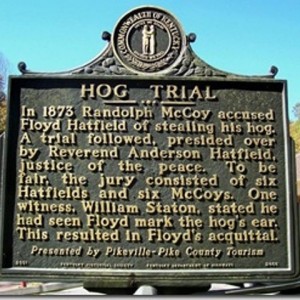

The cultist can be shown the Logan County Court record that gives the name of the justice of the peace in the proceedings against Sam McCoy as A.W. Ferrell, and he will still believe the claims of the feud fabulists–and the concrete sign shown above–that the presiding justice was Wall Hatfield.
(Click to expand graphic)

If you click to expand the above graphic, you can probably see that five of the names of witnesses AGAINST Sam McCoy were named “McCoy.” The complete list of prosecution witnesses includes eight McCoys. Neither the appearance of eight McCoys as witnesses against Sam, nor the fact that there were only sixty McCoys of arms-bearing age in the Valley in the 1880 Census prevents King from claiming that over a hundred armed McCoys invaded Logan that year in support of Sam McCoy (p.85). Of course the cultists believe King.
Show a cultist the Pike County Court records proving that Jim Vance signed the bond for Perry Cline when Cline entered the office of Sheriff, and that Cline later appointed Vance a deputy sheriff, and they will still say that Cline believed that Vance murdered his brother-n-law, Harmon McCoy, and that Cline hated Vance because of the “murder.”
In discussing the cult, I like to consider also a quote from a notorious unbeliever, Mark Twain. In “Following the Equator,” Twain wrote: “Truth is stranger than fiction, but it is because Fiction is obliged to stick to possibilities…” Physical impossibility is no deterrent to belief on the part of a cultist.
If a writer of fiction said that 1200 people normally attended Preacher Anse’s church (which had 28 members), he would be dismissed out of hand. Dean King can write the same thing in a book he claims is the “True Story,” and be acclaimed by the cult as a historian whose research is exhaustive, and whose integrity is impeccable.
Show a cultist the work of Grace Dotson (Appalachian Quarterly, September, 2003, p. 40) and Barbara Cherep, http://tgv7.tripod.com/index-12.html proving beyond any doubt—from the record—that Abner Vance spent the entire time from his crime to his hanging in jail, and they will still believe the West Virginia Encyclopedia, which says that Vance absconded to the wilds of Tug Valley and founded a family there. http://www.wvencyclopedia.org/articles/279
The defining “truth” of the cult is the claim that Ran’l McCoy was a blameless victim. Any writer who sticks to that tenet can write absolutely anything he wants to write—no matter how outrageously false—and still have the cult’s approval.
For example: Dean King wrote that Ellison Hatfield started the Election Day fight by drawing a knife on Tolbert McCoy. That lie morphs the highly-respected Ellison Hatfield into a would-be murderer who got only what was coming to him. It makes his brother, Anse, a cold-blooded murderer, who killed three innocent men for no reason other than that he was a pathological killer. It also makes Preacher Anse Hatfeild a willing accessory to the murders of three innocent men. If the King lie is accepted as true, then Preacher Anse ordered the arrest of three men whom he knew–he was an eyewitness–to be innocent.
Of course it also makes Ran’l McCoy the only surviving innocent victim, and that wins the approval of the cult for anything else in the book, no matter how obviously false it is.
We see cultists who are descendants of all three—Ellison, and the two Andersons—lending their words and photos to the selling of King’s libel of their ancestors.
Because their faith is independent of the evidence, arguing with a cultist is utterly useless. They will never state anything as a fact, thereby submitting it to examination by the record. If their opponent states a fact, they will either totally ignore it, or they will twist it into something that they can attack.
For example, I frequently make the claim that the troubles in Tug Valley during the 1880’s do not fit the dictionary definition of a “feud.” This is invariably distorted by the cultists, who say that I deny that Devil Anse killed three McCoys at the paw paw grove.
Arguing with a member of the cult is the equivalent of trying to convince a Muslim that Muhammad was not a prophet, and there is no profit to be gained in either endeavor. I frequently resolve to stop responding to them. I hope someday to be able to abide by that resolution.

